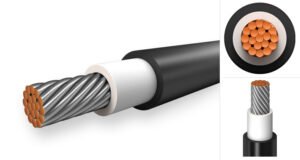A solar cable serves as the interconnection cable utilized in photovoltaic power generation. It links together solar panels and other electrical components within a photovoltaic system. Engineered to withstand UV exposure and varying weather conditions, solar cables operate effectively across a wide temperature range and are typically installed outdoors.

CONSTRUCTION OF THE CABLE
| CONDUCTORS: | It is the current carrying component of the cable. |
| Material | Flexible Class 5 -Tinned annealed copper to IEC 60228 |
| INSULATION: | The rated voltage level of the cable depends on the dielectric strength and thickness of the insulation |
| Material | Cross Linked (XLPO) to BSEN 50618:2014 1.5KVDC |
| OUTER SHEATH: | Cross Linked (XLPO) to BS EN 50618:2014. |
| COLOUR OF OUTERSHEATH JACKET : | Black (Other colours on request) |
CHARACTERISTICS
| Operating temperature: | -40° C to +120° C. |
| Short circuit: | *The short circuit rating is calculated based on the condition of normal maximum operating conductor temperature of 120°C prior to short circuit and maximum conductor temperature of 250°C after the short circuit. |
| Voltage: | 1.5 kVDC |
STANDARDS
| Cable standard: | BS EN 50618 & TUV 2 PFG 1169/08 |
| Outer Sheath: | BS EN 50618:2014 |
| Conductor: | IEC 60228 |
APPLICATION: Solar cable is the interconnection cable used in photovoltaic power plants, they connect solar panels and other electrical components of a photovoltaic system. The cables are suitable to be used with class II equipment as per BS50618.
